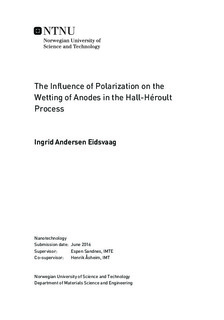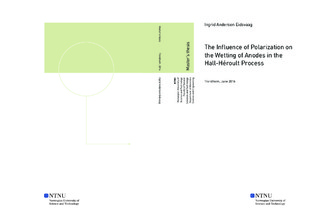| dc.description.abstract | Improvements in the Hall Héroult process for aluminium electrolysis has lead to a reduction in energy consumption from 20-25 kWh/kg Al 70 years ago, down to around 13-14 kWh/kg Al on average today. In order to further reduce energy consumption, it is important to look into bubble formation on the anode surface, and the shielding effect caused by this. The shielding of surface by the bubbles is amongst others related to how well the cryolite wets the anode surface.
In addition to reducing energy consumption, it is also necessary to look into reduction of emissions of greenhouse gases from the electrolysis process.
One of the most important type of greenhouse gases produced in aluminium electrolysis is the perfluorocarbons. Perfluorocarbons are produced during anode effect, which may occur if the alumina concentration in the melt becomes too low.
Though the exact mechanism causing anode effects is not known, it appears related to the ability of the electrolyte to wet the anode.
In this project, a lab scale electrolysis cell with a weight sensor on the anode was used to investigate trends in wettability during and after polarization both at normal operating voltages and at anode effect inducing ones. The electrolyte consisted of a cryolite melt with a cryolite ratio of 2.3 and 1 wt% Al2O3. Various anode designs and carbon in the form of graphite, glassy carbon and industrial pitch and coke were used.
It was found that both bubble coverage and average size of detaching bubbles decreased with increasing current density on the anode. This is believed to be mostly due to increased stirring of the melt caused by the extra bubbles formed. However, it is also possible that parts of the reduction came from improved wettability.
In addition, it was found that the wettability of anodes improved during polarization for normal operating voltages. A sizable fraction of the improvement in wettability occurred in the first few seconds of polarization, but it still took several minutes of polarization to obtain the best wettability. For voltages inducing anode effect, the wettability dropped quickly and a stable poor wettability is obtained already after a few seconds. This change preceded any changes in surface roughness of the anode, suggesting that it was caused by creation of CF-bonds on the surface. Testing with graphite, glassy carbon and industrial coke mixture revealed much the same trends in wetting behavior, however glassy carbon was much more resistant to anode effects and regained good wettability more quickly when polarized at normal operating voltages. | |

